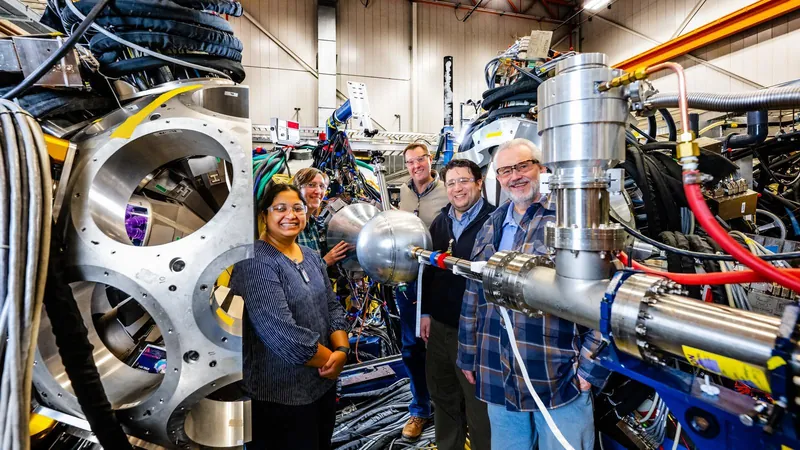
Revolutionary Gamma-Ray Detector Set to Transform Our Understanding of Atomic Nuclei
2025-08-21
Author: Jacob
A Major Leap in Nuclear Physics
In an incredible advancement for nuclear physics, researchers have reached a pivotal milestone in the development of the Gamma-Ray Energy Tracking Array (GRETA). This cutting-edge detector, spearheaded by the U.S. Department of Energy’s Lawrence Berkeley National Laboratory and supported by institutions including Argonne, Oak Ridge, and Michigan State University, is set to uncover the secrets of atomic nuclei.
The Quest to Understand Atomic Nuclei
For decades, the study of atomic nuclei has driven significant technological innovations—from MRI scans that revolutionize medicine to the nuclear power that illuminates homes across the globe. Yet, despite these advancements, scientists admit our grasp of the nucleus—the atom's dense core—remains enigmatic.
Building a Cutting-Edge Nuclear Microscope
GRETA aims to change this narrative by offering an unmatched perspective on the fundamental forces that bind matter. The project has successfully produced its core components, featuring thirty ultra-pure germanium detector modules, precision electronics, and state-of-the-art computing capabilities. Once operational, GRETA will be ten to a hundred times more sensitive than previous models, enabling scientists to detect previously unseen faint nuclear structures.
Unlocking the Mysteries of Exotic Isotopes
Soon to be sent to the Facility for Rare Isotope Beams (FRIB) at Michigan State University, GRETA will analyze exotic isotopes created by colliding particle beams with target materials. Many of these isotopes exist only briefly, but GRETA's exceptional sensitivity will allow scientists to explore their properties in depth, revealing insights into their structures.
Unravelling the Universe's Fundamental Questions
The implications of GRETA’s findings extend well beyond the laboratory walls. At FRIB and Argonne’s ATLAS, researchers will investigate pear-shaped atomic nuclei, potentially unlocking profound answers to why our universe predominantly comprises matter rather than antimatter. Additionally, GRETA will simulate conditions inside stars, providing a better understanding of how heavy elements are forged during stellar explosions.
Engineering Marvel Meets Technological Power
The sophistication of GRETA lies not only in its engineering but also in its computational prowess. Constructed with unparalleled precision, the detector is designed to capture up to 511,000 gamma-ray interactions per second. Its advanced trigger system filters through the flood of data, ensuring that only the most significant signals are recorded.
From GRETINA to GRETA: An Evolution
GRETA builds on the success of its predecessor, GRETINA, which utilized twelve germanium modules. By incorporating these existing detectors into GRETA’s 30-module spherical array, researchers will greatly enhance their ability to visualize and reconstruct nuclear interactions, dramatically speeding up data collection and analysis.
Preparing for Groundbreaking Experiments
Scheduled for installation at FRIB by 2026, GRETA will soon embark on a journey to various experimental facilities, maximizing its impact on nuclear structure research. By 2028, it may also serve at Argonne's ATLAS accelerator, offering more opportunities for groundbreaking studies.
The Dawn of a New Era in Nuclear Research
As GRETA prepares to change the landscape of nuclear physics, scientists are eager to tackle essential questions about atomic nuclei and the forces at play. From deciphering the origins of matter in the universe to exploring nuclear stability, GRETA is not just a scientific instrument—it's a revolutionary lens through which the hidden intricacies of matter will be revealed, one gamma ray at a time.









 Brasil (PT)
Brasil (PT)
 Canada (EN)
Canada (EN)
 Chile (ES)
Chile (ES)
 Česko (CS)
Česko (CS)
 대한민국 (KO)
대한민국 (KO)
 España (ES)
España (ES)
 France (FR)
France (FR)
 Hong Kong (EN)
Hong Kong (EN)
 Italia (IT)
Italia (IT)
 日本 (JA)
日本 (JA)
 Magyarország (HU)
Magyarország (HU)
 Norge (NO)
Norge (NO)
 Polska (PL)
Polska (PL)
 Schweiz (DE)
Schweiz (DE)
 Singapore (EN)
Singapore (EN)
 Sverige (SV)
Sverige (SV)
 Suomi (FI)
Suomi (FI)
 Türkiye (TR)
Türkiye (TR)
 الإمارات العربية المتحدة (AR)
الإمارات العربية المتحدة (AR)